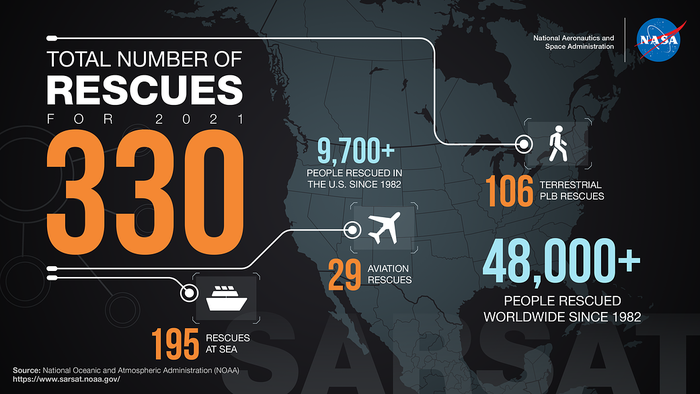NASA Emergency Beacons Save Lives in 2021
In 2021, NASA technology saved 330 lives in the U.S. network region of the international satellite-aided search and rescue effort.

[Jan 19, 2022: NASA/Goddard Space Flight Center]
In 2021, NASA technology saved 330 lives in the U.S. network region of the international satellite-aided search and rescue effort, Cospas-Sarsat. www.sarsat.noaa.gov. (CREDIT: NOAA)
In 2021, NASA technology saved 330 lives in the U.S. network region of the international satellite-aided search and rescue effort, Cospas-Sarsat. NASA has lent technical expertise to the Cospas-Sarsat program since its founding, aiding in the rescue of over 48,000 individuals globally.
Users purchasing commercially available 406 MHz frequency Cospas-Sarsat beacons have free access to the network, which provides accurate and reliable emergency location services. When users activate these beacons, they send signals through satellite instruments to ground stations that can calculate their position. The network then alerts first responders to the location and nature of the emergency.
Beacons are available in three types: Personal Locator Beacons (PLBs), for use by hikers and other explorers; Emergency Position Indicating Radio Beacons (EPIRBs), designed for maritime use; and Emergency Locator Transmitters (ELTs) for aviation. In 2021, 106 rescues were PLBs, 195 were EPIRBS, and 29 were ELTs.
Related Stories:
In recent years, NASA’s Search and Rescue (SAR) office has helped Cospas-Sarsat to enhance its network with aviation studies, next-generation beacon technology, and new capabilities for Artemis astronauts. The office is also working on a lunar search and rescue concept, or LunaSAR, as part of NASA’s lunar network development effort, LunaNet.
The National Oceanic and Atmospheric Administration (NOAA) manages the U.S. network region for Cospas-Sarsat, which relies on flight and ground technologies developed by SAR at NASA’s Goddard Space Flight Center in Greenbelt, Maryland. NASA’s Space Communications and Navigation (SCaN) program at NASA Headquarters provides strategic oversight to the SAR office. Saves are made by the U.S. Coast Guard, U.S. Air Force, and local rescue authorities.
For more science news stories check out our New Discovery section at The Brighter Side of News.
Note: Materials provided above by NASA/Goddard Space Flight Center. Content may be edited for style and length.
Like these kind of feel good stories? Get the Brighter Side of News' newsletter.
Tags: #New_Discovery, #Satellites, #Space, #Rescue, #NASA, #Science, #Technology, #Research, #The_Brighter_Side_of_News
Joseph Shavit
Head Science News Writer | Communicating Innovation & Discovery
Based in Los Angeles, Joseph Shavit is an accomplished science journalist, head science news writer and co-founder at The Brighter Side of News, where he translates cutting-edge discoveries into compelling stories for a broad audience. With a strong background spanning science, business, product management, media leadership, and entrepreneurship, Joseph brings a unique perspective to science communication. His expertise allows him to uncover the intersection of technological advancements and market potential, shedding light on how groundbreaking research evolves into transformative products and industries.



